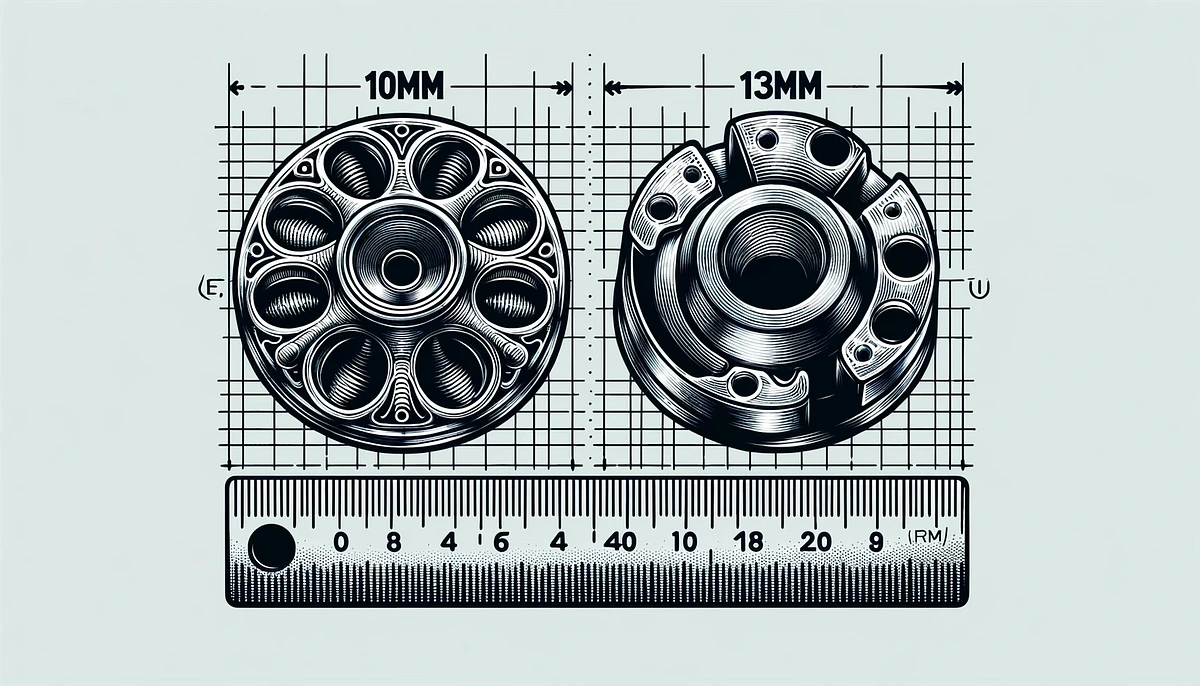Have you ever wondered why some earbuds sound better than others? Or why certain headphones deliver that perfect bass response while others fall flat? The secret often lies in a tiny but crucial component: the driver. Today, I’m diving deep into the world of audio drivers, specifically comparing 10mm drivers versus 13mm drivers to help you understand which might be better for your listening needs.
Also Read:
TWS Earbuds Under 1000 INR
Tws Earbuds Under 1500 INR
TWS Earbuds Under 2000 INR
As someone who’s tested countless audio devices over the years, I’ve come to appreciate how these small differences can dramatically impact sound quality. Let’s explore this topic together in a way that’s easy to understand, even if you’re not an audio engineer.
Also Read:
Does Driver Size Matter in Earbuds?
What Are the Different Types of Bluetooth Audio Codecs and How Do They Affect Sound Quality
How Do I Know When My Earbuds Are Fully Charged?
How Many mm Driver is Good for Earbuds?
How to Reduce Ear Pain from Earbuds
How Long Should You Wear Earbuds a Day?
How Does the Microphone on Earbuds Work?
Can I Connect Smartwatch and Earbuds Together?
Is It Safe to Use Earbuds Without the Mesh?
Understanding Audio Drivers: The Heart of Your Headphones
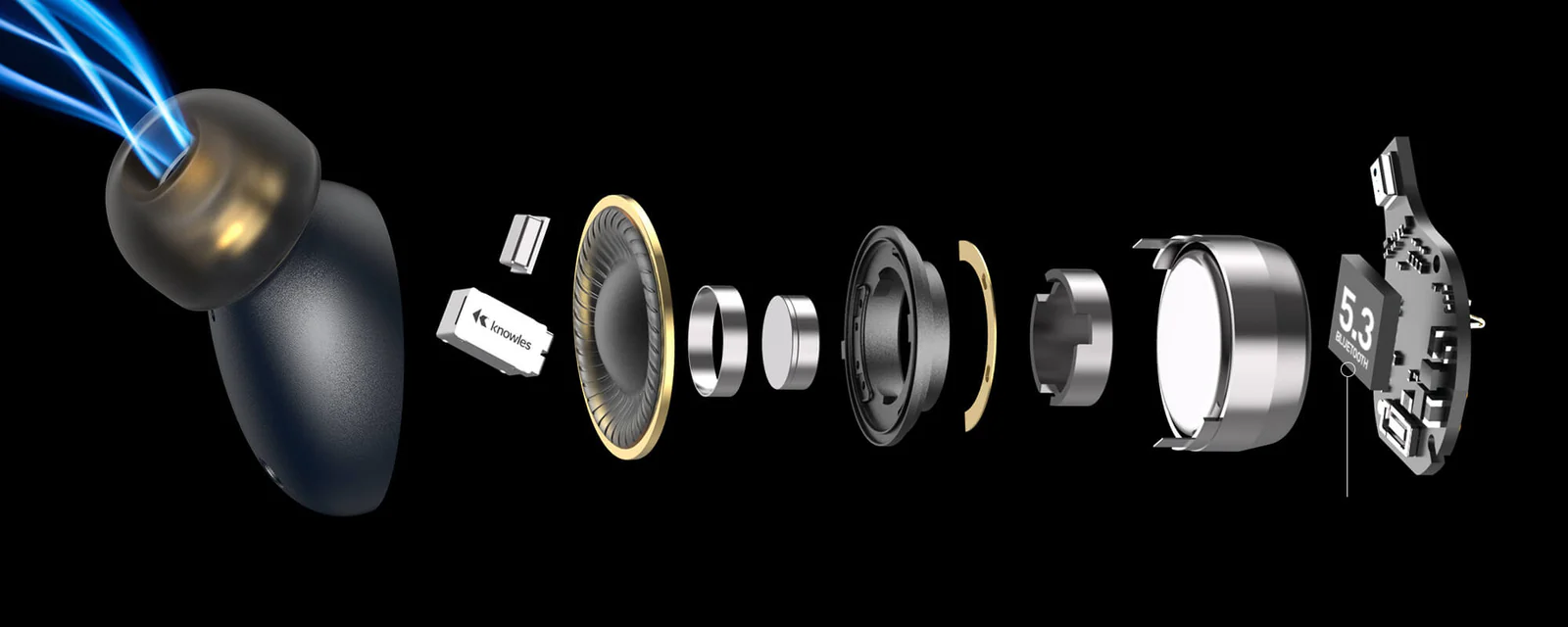
Before we jump into comparing sizes, let’s get clear on what exactly an audio driver is. Simply put, a driver is the component in your headphones or earbuds that converts electrical signals into sound waves that your ears can hear. Think of it as the “speaker” inside your listening device.
The driver consists of several key components:
- A magnet
- A voice coil
- A diaphragm
When electrical current (your music signal) passes through the voice coil, it creates a magnetic field that interacts with the permanent magnet. This causes the attached diaphragm to vibrate, which produces the sound waves you hear. Pretty cool, right?
Now, why does size matter? The diameter of the driver (measured in millimeters) affects how the driver performs, particularly in how it reproduces different frequencies. This is where our 10mm vs 13mm comparison comes into play.
10mm Drivers: The Compact Powerhouses
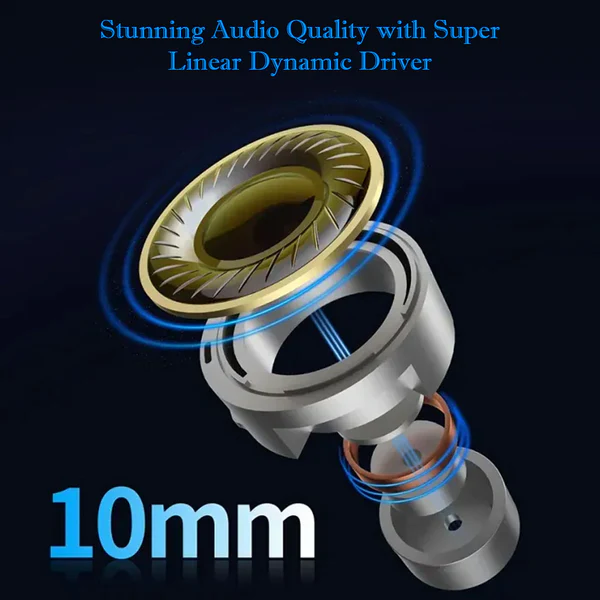
10mm drivers are relatively small and are commonly found in earbuds and in-ear monitors (IEMs). Despite their compact size, these little performers pack quite a punch.
Characteristics of 10mm Drivers
The 10mm driver has become something of an industry standard for many earbuds, and for good reason. These smaller drivers offer:
- Excellent portability due to their compact size
- Lighter weight, making them comfortable for extended wear
- Precise sound reproduction, especially in mid and high frequencies
- Lower power requirements to achieve decent volume levels
I recently tested a pair of earbuds with 10mm drivers during my morning runs, and I was impressed by how they stayed secure while delivering clear vocals and crisp highs, even as I was bouncing along the trail.
Pros of 10mm Drivers
- Enhanced comfort for long listening sessions
- Superior detail in mid and high frequencies
- Better fit in smaller ear canals
- Excellent for portable devices with limited power output
- Typically more affordable than larger driver options
Cons of 10mm Drivers
- Sometimes lacking in bass response compared to larger drivers
- May not deliver the same sense of soundstage as larger drivers
- Can sound thin with certain music genres that demand powerful low frequencies
13mm Drivers: The Bigger Contenders
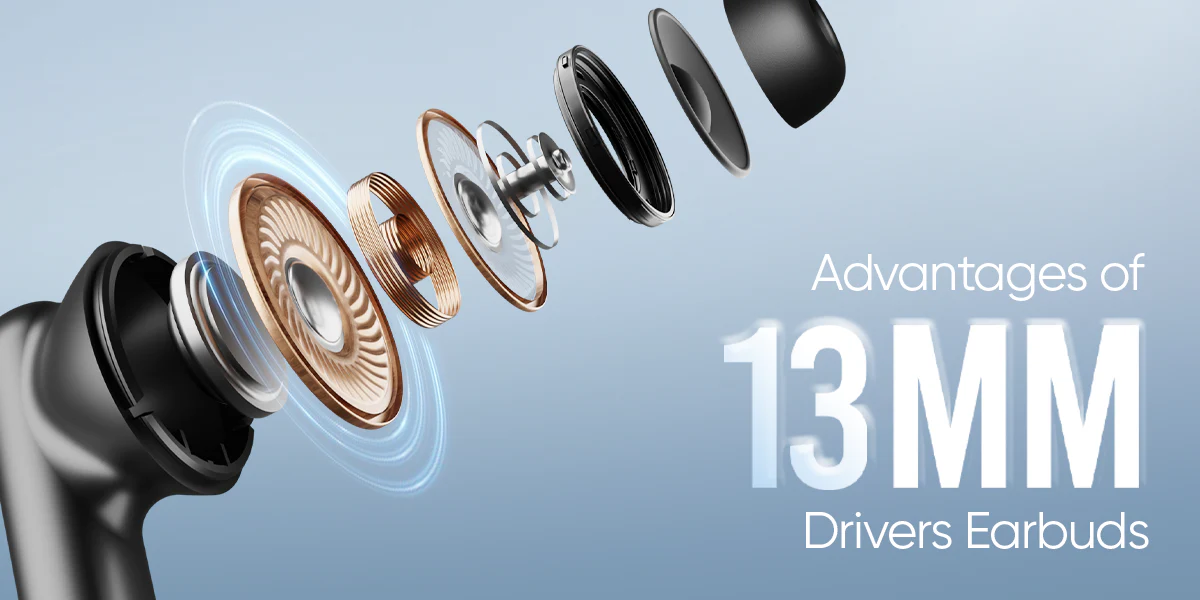
Moving up in size, 13mm drivers represent a significant jump in driver diameter. These larger drivers are often found in higher-end earbuds, some in-ear monitors, and smaller on-ear headphones.
Characteristics of 13mm Drivers
The additional 3mm makes a noticeable difference in several aspects:
- Enhanced bass response due to the larger diaphragm surface area
- Greater air movement capability, creating more powerful sound
- Wider soundstage potential, giving music more room to breathe
- Higher maximum volume capabilities before distortion
Last month, I switched to earbuds with 13mm drivers for a long-haul flight, and the difference in immersion was noticeable. The movie soundtrack felt more cinematic, with explosions carrying more weight and orchestral pieces feeling more expansive.
Pros of 13mm Drivers
- Richer, more powerful bass reproduction
- Fuller overall sound signature
- Better dynamic range potential
- More impactful listening experience for bass-heavy genres
- Often preferred for movies and gaming due to their immersive quality
Cons of 13mm Drivers
- Larger physical size may cause comfort issues for some users
- Heavier weight can lead to fatigue during extended use
- Higher power requirements to drive effectively
- Usually more expensive than smaller driver options
- Can be too bassy for listeners who prefer neutral sound
Comparing 10mm and 13mm Drivers: The Sound Quality Showdown
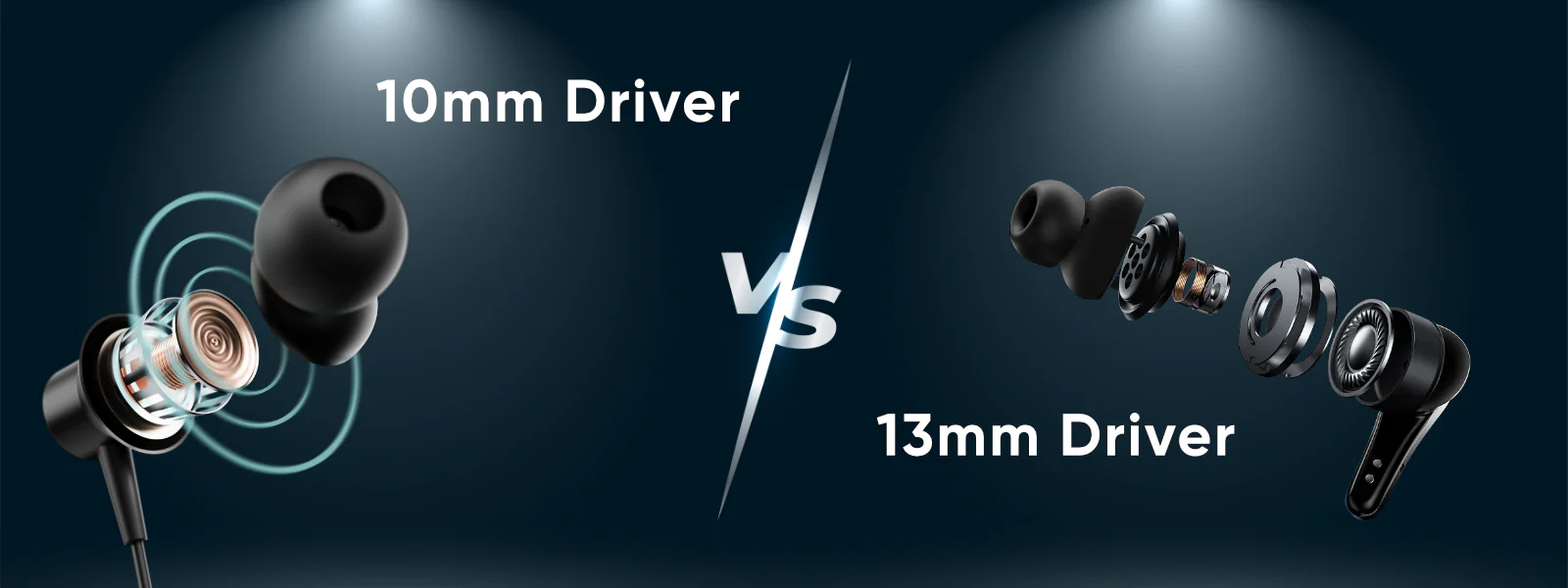
Now that we understand each driver size individually, let’s put them head-to-head across various sound quality aspects.
Bass Response
This is perhaps the most noticeable difference between these two driver sizes.
10mm Drivers: These smaller drivers can certainly produce bass, but they typically offer a tighter, more controlled low-end response. The bass tends to be quicker and more precise but may lack the physical impact that some listeners crave.
13mm Drivers: With their larger diaphragm surface area, 13mm drivers can move more air, resulting in more powerful, extended bass that you can often “feel” as well as hear. This makes them popular for bass-heavy music genres like EDM, hip-hop, and certain rock styles.
During my testing of both sizes, I found that listening to Billie Eilish’s “bad guy” revealed clear differences. The 13mm drivers gave the song’s distinctive bass line more weight and presence, while the 10mm drivers presented a cleaner, more balanced version that emphasized the vocal details.
Midrange Clarity
The midrange is where vocals and most instruments live, making it crucial for overall music enjoyment.
10mm Drivers: Generally excel in midrange reproduction, offering clear, detailed vocals and instrument separation. Their smaller size often results in less bass bleeding into the mids, keeping them clean and articulate.
13mm Drivers: Can deliver fuller-bodied midrange with more warmth, but sometimes at the expense of absolute clarity. The stronger bass response might occasionally overshadow subtle midrange details in poorly tuned models.
When I listened to Adele’s “Someone Like You” through both driver sizes, the 10mm drivers seemed to present her voice with slightly more intimacy and detail, while the 13mm drivers gave her voice more body and emotional weight.
Treble Performance
High frequencies affect our perception of detail, sparkle, and airiness in music.
10mm Drivers: Often deliver crisp, extended treble with excellent detail retrieval. Their lighter diaphragms can respond quickly to high-frequency signals.
13mm Drivers: Can produce smoother treble that’s less prone to harshness, though sometimes with slightly less extension at the very highest frequencies.
Testing classical pieces like Vivaldi’s “Four Seasons” showed that the 10mm drivers captured more of the subtle bow sounds and ambient room details, while the 13mm drivers presented a more cohesive, natural sound overall.
Technical Comparison Table
| Aspect | 10mm Drivers | 13mm Drivers |
|---|---|---|
| Bass Response | Tighter, more controlled, less impact | Fuller, more powerful, greater extension |
| Midrange | Clear, detailed, well-separated | Warmer, fuller-bodied, occasionally less detailed |
| Treble | Crisp, extended, detailed | Smoother, sometimes less extended |
| Soundstage | More intimate, precise imaging | Wider, more spacious presentation |
| Detail Retrieval | Excellent for micro-details | Good for overall musical picture |
| Power Requirements | Lower, more efficient | Higher, may need amplification |
| Physical Comfort | Better for smaller ears, lighter | May cause fatigue, heavier |
| Typical Price Range | $20-150 for quality options | $50-300+ for quality options |
Factors Influencing Driver Performance Beyond Size

While size is important, it’s not the only factor that determines how good a driver sounds. Several other elements play crucial roles:
Driver Material
The materials used in the diaphragm significantly impact sound quality. Common materials include:
- Beryllium: Offers excellent rigidity with low mass, resulting in fast response and detailed sound
- Titanium: Provides good strength-to-weight ratio for balanced performance
- Bio-cellulose: Delivers natural timbre with good detail
- Dynamic polymer blends: Found in many consumer models, offering decent performance at lower costs
I’ve found that a well-designed 10mm beryllium driver can outperform a basic 13mm polymer driver in many aspects of sound quality, showing that material quality often trumps size.
Magnet Strength
The magnetic system behind the driver plays a huge role in performance:
- Neodymium magnets are powerful and commonly used in premium models
- Stronger magnets provide better control over the diaphragm movement
- Better control leads to lower distortion and more accurate sound
Voice Coil Design
The voice coil is the component that moves the diaphragm:
- Lighter voice coils respond faster to audio signals
- Copper-clad aluminum voice coils balance conductivity with weight
- The winding technique affects power handling and efficiency
Diaphragm Construction
How the diaphragm is designed affects its performance:
- Thinner diaphragms respond faster but may distort more easily
- Stiffer materials maintain their shape under pressure for cleaner bass
- Multi-layer designs can optimize different frequency ranges
Use Cases and Preferences: Finding Your Perfect Match
Different listening scenarios call for different driver sizes. Let’s explore which might work better for various uses:
Music Genres
10mm Drivers Shine With:
- Classical music: Where detail and instrument separation are paramount
- Acoustic and folk: Where natural timbre of instruments matters
- Vocal-focused music: Where clarity of voices is essential
- Jazz: Where subtle details and nuances need to be preserved
13mm Drivers Excel With:
- EDM and electronic music: Where bass impact and energy are crucial
- Hip-hop and R&B: Where bass foundation drives the music
- Rock and metal: Where fuller sound and power are desired
- Movie soundtracks: Where dynamic range and impact create immersion
Gaming and Movies
For competitive gaming where hearing footsteps and positional audio cues is critical, 10mm drivers often provide the detail and accuracy needed to gain a competitive edge.
For immersive gaming and movie watching, 13mm drivers typically deliver a more cinematic experience with impactful explosions and fuller environmental sounds.
I spent a weekend comparing both driver sizes while playing “Call of Duty” and found that the 10mm drivers helped me locate enemies more precisely, while the 13mm drivers made the overall experience more exciting and immersive.
Portability Considerations
If you’re always on the move:
- 10mm drivers typically result in smaller, lighter earbuds that are more comfortable for all-day wear and easier to carry
- 13mm drivers might require larger housings but provide more satisfying sound for commutes or travel
Personal Anatomy
Everyone’s ears are different, and this affects which driver size might work better for you:
- Smaller ear canals often find better comfort with 10mm driver earbuds
- Larger ear canals may achieve better seal and bass response with 13mm driver models
Technical Specifications Comparison
When shopping for headphones or earbuds, you’ll encounter various specifications. Here’s how they typically compare between 10mm and 13mm drivers:
Frequency Response
10mm Drivers: Often rated for approximately 20Hz-20kHz, with actual bass extension typically rolling off around 30-40Hz
13mm Drivers: Similarly rated for 20Hz-20kHz, but with actual bass extension often reaching lower, around 20-30Hz
Remember that manufacturer claims about frequency response can be misleading. What matters more is how flat or balanced the response is across the frequency range.
Impedance and Sensitivity
10mm Drivers: Typically offer lower impedance (16-32 ohms) and good sensitivity (95-105 dB/mW)
13mm Drivers: May have slightly higher impedance (24-40 ohms) with similar sensitivity values
This means 10mm drivers are often slightly easier to drive from portable devices like phones, while some 13mm drivers might benefit from additional amplification.
Total Harmonic Distortion (THD)
10mm Drivers: Generally exhibit very low THD in the mids and highs, with potential for increased distortion at high volumes in the bass
13mm Drivers: Often maintain lower THD in the bass regions even at higher volumes
Lower THD means cleaner, more accurate sound reproduction, especially important for audiophiles.
Popular Headphones and Earbuds Showcasing Each Driver Size
To give you some real-world examples, here are some well-regarded models featuring each driver size:
Notable 10mm Driver Models
- Sony WF-1000XM4: Premium true wireless earbuds with excellent detail and balanced sound
- Samsung Galaxy Buds Pro: Feature-rich earbuds with clear, detailed audio
- Moondrop Aria: Budget audiophile IEMs with impressive technical performance
- Tin HiFi T2: Affordable dual-driver IEMs with neutral tuning
- Shure SE215: Professional in-ear monitors known for isolation and clarity
Notable 13mm Driver Models
- Sennheiser Momentum True Wireless 3: Premium earbuds with rich, dynamic sound
- 1More Triple Driver: Hybrid earphones with powerful, engaging presentation
- Fiio FH3: Audiophile IEMs with impressive technical capabilities
- Beyerdynamic Soul Byrd: Wired earbuds with detailed, spacious sound
- Final Audio E5000: High-end IEMs with warm, immersive signature
The Impact of Other Factors on Sound Quality
While we’ve focused on driver size, several other factors significantly influence your listening experience:
Headphone/Earbud Design and Construction
- Acoustic chamber design shapes the sound significantly
- Venting systems affect bass response and soundstage
- Ear tip material and design impact seal, comfort, and bass response
I’ve tested identical driver sizes that sound completely different due to housing design differences. A well-designed acoustic chamber can make a 10mm driver sound much bigger than it is.
Audio Source Quality
- Streaming quality (standard vs. high-resolution) affects what you hear
- DAC (Digital-to-Analog Converter) quality in your device matters
- File formats (MP3 vs. FLAC vs. WAV) contain different amounts of information
Amplification
- Proper amplification can help drivers reach their full potential
- Impedance matching between source and headphones affects sound
- Output impedance of your device can change the frequency response
Personal Ear Anatomy
- Ear canal size and shape affect how sound resonates
- Individual hearing sensitivity varies between people
- Fit and seal dramatically impact bass response and isolation
Choosing Between 10mm and 13mm Drivers: Decision Factors
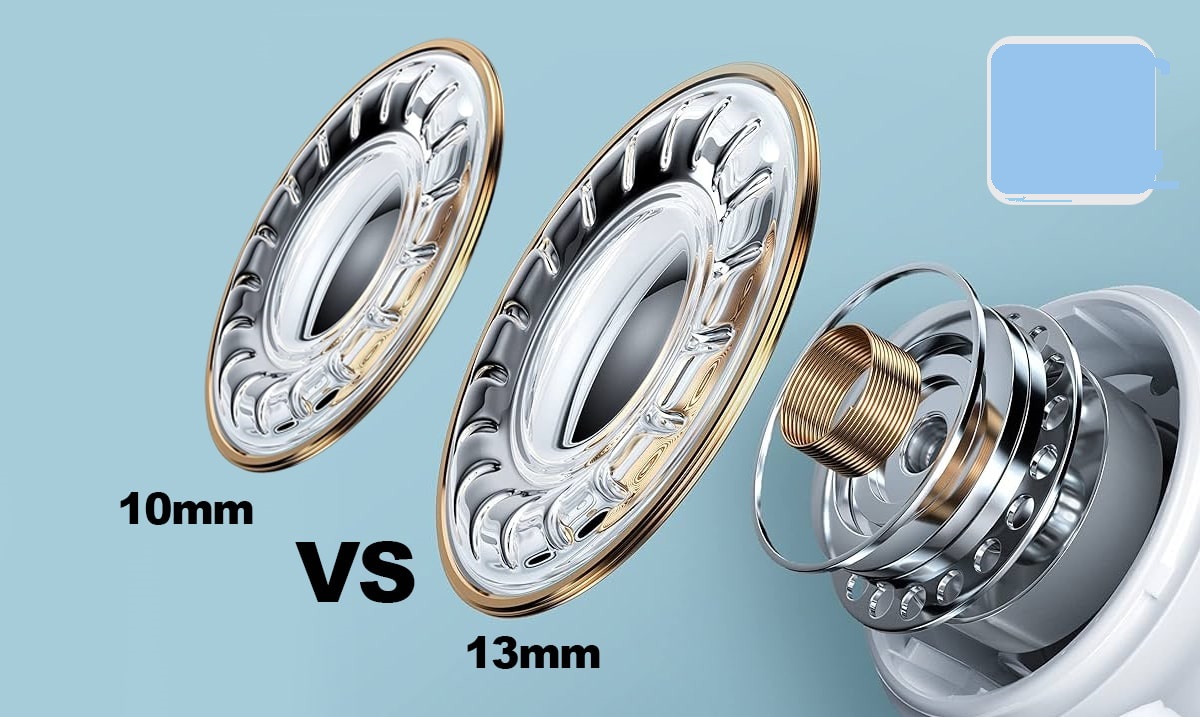
So how do you decide which is right for you? Consider these factors:
Listening Preferences
- Do you value detail and clarity above all? Consider 10mm drivers
- Is powerful bass and immersion your priority? Look toward 13mm drivers
- Do you listen primarily to vocal music? 10mm might serve you better
- Are electronic and bass-heavy genres your favorites? 13mm could be ideal
Comfort and Fit
- Do you have smaller ear canals? 10mm driver earbuds typically have smaller housings
- Do you experience ear fatigue easily? Lighter 10mm options might be more comfortable
- Do you get a good seal with most earbuds? Either size could work well
Usage Scenarios
- Primarily for exercise? Lighter 10mm drivers might stay in place better
- For home listening sessions? 13mm drivers might provide a more satisfying experience
- For office or commuting? Consider which aspects of sound matter most in those environments
Budget Considerations
While there are exceptions, generally:
- Entry-level models with 10mm drivers often provide better value
- Premium models with 13mm drivers may justify their higher cost through enhanced bass and fullness
Future Trends in Driver Technology
The audio world doesn’t stand still. Here are some exciting developments affecting driver technology:
Advanced Materials
Manufacturers continue to develop new materials for driver components:
- Graphene-coated diaphragms offering incredible stiffness-to-weight ratios
- Carbon nanotube technology providing faster response times
- Biocellulose composites delivering natural sound with technical precision
These advancements mean that future 10mm drivers might overcome traditional limitations in bass response, while 13mm drivers could become lighter and more detailed.
Hybrid Driver Systems
Many manufacturers are combining different driver types:
- Multiple dynamic drivers handling different frequency ranges
- Dynamic + balanced armature combinations for the best of both worlds
- Planar magnetic + dynamic hybrids for detail and power
This trend suggests that the simple comparison of 10mm vs. 13mm may become less relevant as hybrid systems grow more common.
Digital Signal Processing (DSP)
Software is increasingly important in shaping sound:
- App-based EQ allowing customization of frequency response
- Adaptive sound that changes based on environment
- Spatial audio processing creating more immersive experiences
With advanced DSP, the physical limitations of different driver sizes can be partially overcome through clever signal manipulation.
Conclusion: Which Driver Size Reigns Supreme?
After this deep dive into 10mm vs. 13mm drivers, you might be wondering which is objectively “better.” The truth is, there’s no one-size-fits-all answer.
10mm drivers excel in situations where detail, clarity, comfort, and portability are priorities. They’re often the better choice for:
- Listeners with smaller ears
- Those who prioritize vocal clarity and instrument separation
- People who wear earbuds for extended periods
- Listeners who enjoy acoustic, classical, and detail-oriented genres
13mm drivers shine when immersion, power, bass impact, and fuller sound are desired. They typically work better for:
- Bass enthusiasts
- Movie watchers and immersive gamers
- Listeners who enjoy EDM, hip-hop, and rock
- Those who prioritize dynamic range and impact over absolute detail
In my experience testing countless models with both driver sizes, I’ve found that driver implementation matters more than size alone. A well-designed 10mm driver in a properly tuned acoustic chamber can outperform a mediocre 13mm driver in almost every aspect.
My advice? Rather than fixating on driver size specifications, consider:
- The overall sound signature you prefer
- The comfort and fit that works for your ears
- The specific implementation and tuning of the model
- What actual users and reviewers say about the sound
Whenever possible, try before you buy or purchase from retailers with good return policies. Your ears are unique, and personal experience trumps specifications every time.
Frequently Asked Questions
Q1: Can I tell which driver size is in my earbuds just by looking at them?
A: Not usually. While 13mm driver earbuds tend to be larger, manufacturers often design housings of various sizes regardless of the driver inside. Check the product specifications for accurate information.
Q2: Do more expensive earbuds always have larger drivers?
A: No. Many high-end audiophile IEMs use 10mm or even smaller drivers. Price correlates more with overall design quality, materials, and tuning than with driver size.
Q3: Will 13mm drivers always have better bass than 10mm drivers?
A: While 13mm drivers typically have an advantage in bass quantity and extension, a well-designed 10mm driver can produce excellent bass quality that some listeners might prefer for its tightness and control.
Q4: Are 13mm drivers less comfortable than 10mm drivers?
A: They can be, as they often require larger housings, but this varies greatly depending on the overall design of the earbuds and your ear anatomy.
Q5: Do 13mm drivers drain battery faster in wireless earbuds?
A: They might, as larger drivers typically require more power to drive, but modern battery and chip technology has minimized this difference in many current models.
Q6: Can driver size affect noise isolation?
A: Indirectly. Smaller 10mm drivers might allow for deeper insertion designs that provide better passive noise isolation, but this depends more on the overall earbud design than the driver size itself.
Q7: Are hybrid drivers better than single drivers?
A: Not necessarily better, but different. Hybrid setups aim to combine the strengths of different driver types, but a well-implemented single driver can still provide excellent sound quality.
Q8: Do professional audio engineers prefer a specific driver size?
A: Professional preferences vary widely. Many studio engineers use multiple monitoring options, including both smaller and larger driver models, to get different perspectives on their mixes.
Remember, the best audio equipment is the one that sounds best to you and meets your specific needs. Driver size is just one factor in a complex equation that creates your perfect listening experience.

